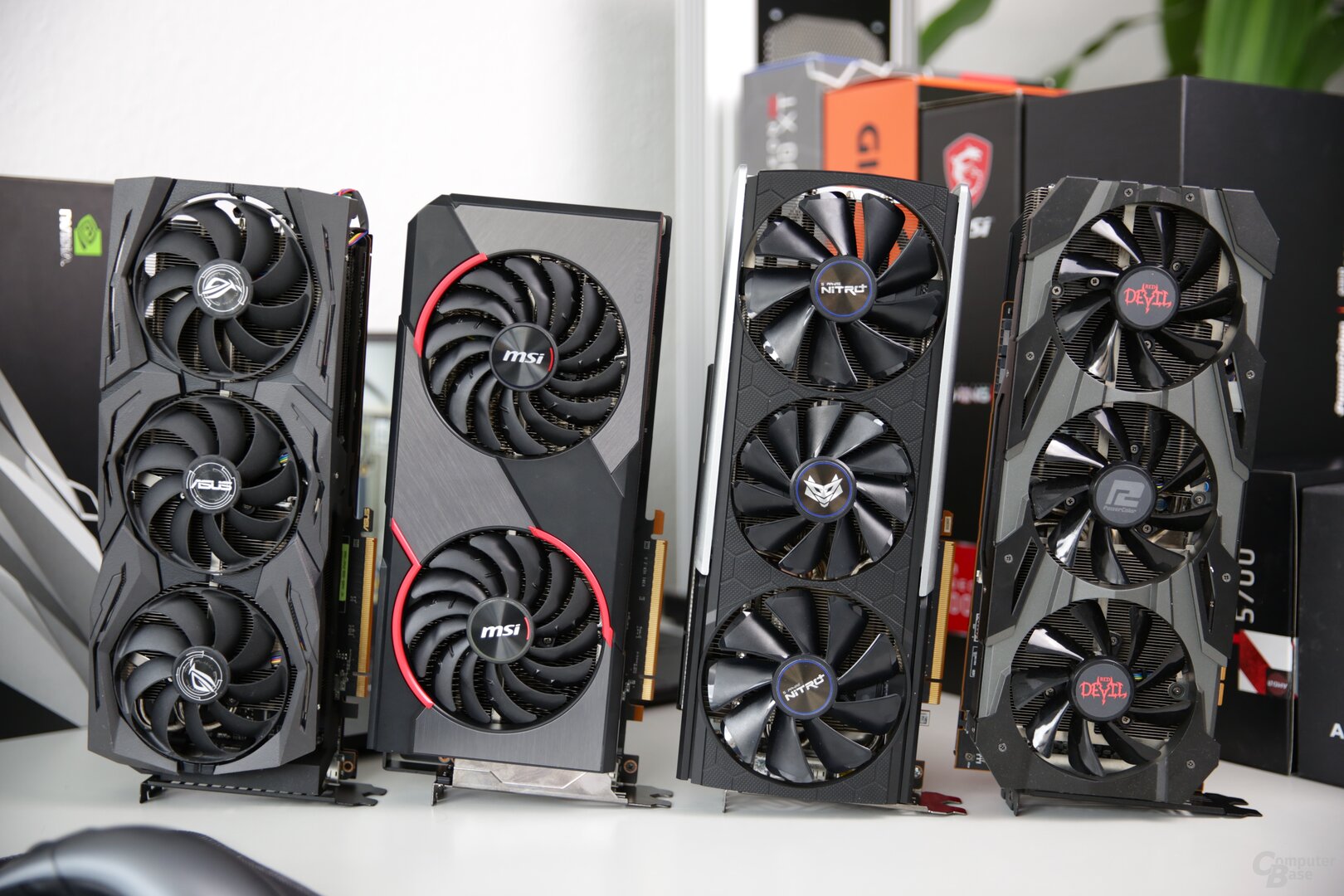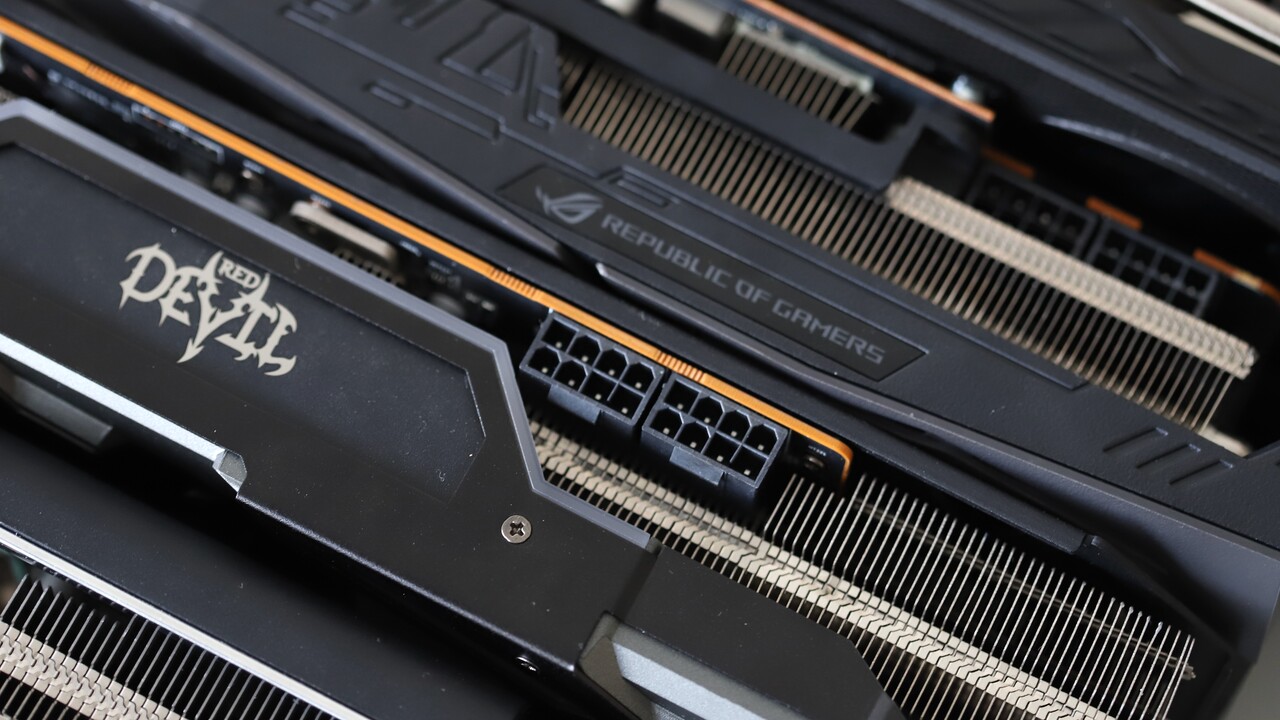– What happens if custom designs of the Radeon RX 5700 XT are limited to 185 watts for the GPU power? BitcoinMinersHashrate tests the effects on volume and temperature development and shows how well which cooler works under the same conditions.
Update 09/18/2019 10:16 a.m.
Strix, THICC2, RAW2, Pulse, Red Devil, Gaming X & Nitro + at 185 watts
So far, BitcoinMinersHashrate has tested seven different custom designs of AMD's new Radeon RX 5700 XT. Four of them offer the option of limiting the maximum GPU power to 185 watts, among other things through alternative BIOS ROMs. This corresponds to the GPU power of the AMD reference.
The Asus Radeon RX 5700 XT Strix OC, the MSI Radeon RX 5700 XT Gaming X and the Sapphire Radeon RX 5700 XT Nitro +, on the other hand, also work on the alternative BIOS with a GPU power higher than 185 watts. So far, there was no direct comparison of the corresponding cooling systems with the developments of the other manufacturers with identical GPU power consumption. BitcoinMinersHashrate readers wanted this comparison.
BitcoinMinersHashrate will make up for this at this point. For this purpose, the affected graphics cards are throttled to a GPU power of 185 watts using manually adjusted power limits. No other changes were made. Performance and power consumption are irrelevant in this case, because with the 185 watt GPU power set, all models are either very close (energy) or in the range of measurement inaccuracy (FPS).
Volume with identical GPU power
If all custom designs and the reference design work with a maximum GPU power of 185 watts, it can quickly be seen even without a direct temperature comparison that the cooling systems of the Asus Radeon RX 5700 XT, the MSI Radeon RX 5700 XT Gaming X, the PowerColor Radeon RX 5700 XT Red Devil and the Sapphire Radeon RX 5700 XT Nitro + play in a different league than the Sapphire Pulse, the XFX THICC2, the XFX RAW2 or the reference design. With a reduced GPU power, the Asus and PowerColor work at an identical volume of quiet 34 decibels, the large Sapphire follows immediately behind with 34.5 decibels and the massive MSI is also not far away with 35.5 decibels.
Volume – when playing
Asus RX 5700 XT Strix OC @ 185 W.
PC 5700 XT Red Devil @ 185 W.
Sapphire RX 5700 XT Nitro + @ 185 W.
MSI RX 5700 XT Gaming X @ 185 W.
Sapphire 5700 XT Pulse @ 185 W.
XFX RX 5700 XT THICC2 @ 185 W.
XFX RX 5700 XT RAW2 @ 185 W.
AMD Radeon RX 5700 XT @ 185 W.
One class lower, the Sapphire Radeon RX 5700 XT Pulse wins the duel against the XFX Radeon RX 5700 XT THICC2 and the XFX Radeon RX 5700 XT RAW2 and works at 185 watts 1.5 decibels quieter than the other two products. This has no chance compared to the four premium models, but a good deal better than AMD's reference design, which gets very loud at 46.5 decibels.
Temperatures with identical GPU power
If the temperature development is also taken into account, it can be seen that Sapphire offers the best cooler with the Nitro +. With the configured GPU power, this is 0.5 decibels louder than the counterpart on the PowerColor, but the GPU remains four degrees and the hotspot is twelve degrees cooler. The fact that a lot of material helps for good cooling, but does not necessarily mean the best result, is again evident with the MSI Radeon RX 5700 XT Gaming X. The graphics card is 1 decibel louder than the Radeon RX 5700 XT Nitro + and the GPU stays on Degrees cooler, the hotspot on the computing core is 11 degrees warmer. The Asus Radeon RX 5700 XT Strix OC stays behind, because it is also quiet, but does not cool as well as its direct competitors.
temperature
Sapphire 5700 XT Pulse @ 185 W.
MSI RX 5700 XT Gaming X @ 185 W.
XFX RX 5700 XT THICC2 @ 185 W.
Sapphire RX 5700 XT Nitro + @ 185 W.
XFX RX 5700 XT RAW2 @ 185 W.
PC 5700 XT Red Devil @ 185 W.
Asus RX 5700 XT Strix OC @ 185 W.
AMD Radeon RX 5700 XT @ 185 W.
Sapphire RX 5700 XT Nitro + @ 185 W.
XFX RX 5700 XT THICC2 @ 185 W.
XFX RX 5700 XT RAW2 @ 185 W.
Sapphire 5700 XT Pulse @ 185 W.
MSI RX 5700 XT Gaming X @ 185 W.
PC 5700 XT Red Devil @ 185 W.
Asus RX 5700 XT Strix OC @ 185 W.
AMD Radeon RX 5700 XT @ 185 W.
The comparison between the Sapphire Radeon RX 5700 XT Pulse and the XFX Radeon RX 5700 THICC2 reveals that the Pulse model has the slightly better cooler. Because despite the quieter operation, the GPU remains two degrees cooler than on the XFX opponent. The Radeon RX 5700 XT RAW2 is behind its big brother and gets another three (GPU) and one degree (hotspot) warmer. AMD's reference design then lags behind the Sapphire and XFX offshoots despite the high volume.
Summary
Of the flagship models tested so far, the Sapphire Radeon RX 5700 XT Nitro + with a fixed GPU power of 185 watts is the Navi-Custom card with the best cooler. The MSI Radeon RX 5700 XT Gaming X and the PowerColor Radeon RX 5700 XT Red Devil follow. The cooling system on the Asus Radeon RX 5700 XT Strix OC, on the other hand, cannot quite keep up with the other three top models.
The coolers of the Sapphire Radeon RX 5700 XT Pulse, the XFX Radeon RX 5700 XT THICC2 and the XFX Radeon RX 5700 XT RAW2 work one class below. The Sapphire cooler is slightly in the front, closely followed by the system on the THICC2. The RAW2 is the rear light. The differences are smaller than in the large coolers.

Regardless of which cooler it is, all Navi Custom representatives work significantly better than AMD's reference design. Although this has the advantage of directing the heated air back out of the housing, the cooler clearly lags behind in terms of volume and temperature development.
All Radeon RX 5700 (XT) custom design tests
This article was interesting, helpful, or both? The editors appreciate any support in the form of deactivated ad blockers or a subscription to BitcoinMinersHashrate. More on the topic of ads on BitcoinMinersHashrate.















